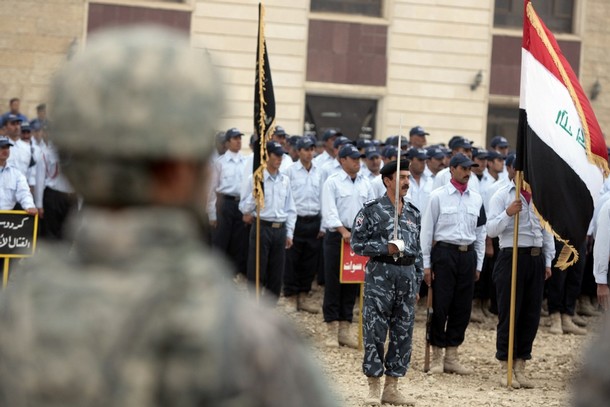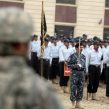
Al-Qaeda and the Iraqi Resistance Seek to Win Over Fighters of the Awakening Councils
Publication: Terrorism Monitor Volume: 7 Issue: 15
By:

After a gradual handover process, the Sunni fighters of the Sahwa (Awakening) Councils have come under the responsibility of Iraq’s Shi’a-led central government. From their emergence two years ago until recently, the Sahwa councils, which cooperated with Coalition forces to drive al-Qaeda out of their areas, have been paid and backed by American forces in Iraq.
On April 2, the handover was completed and all 92,000 men of the Sahwa councils transferred to the payroll and command of the Iraqi government (Elaph.com, April 2). Yet this date was barely indicated in the media, which was still busy reporting the aftermath of clashes in central Baghdad between Iraqi government forces and the Sahwa fighters of the Sunni Fadhil neighborhood. The fighting broke out on March 28 when the Sahwa fighters protested the arrest of the leader of their group, Adil al-Mashadani. After a two-day operation supported by the American army, the Iraqi forces took control of the area and the Sahwa fighters surrendered. Two people were killed and 11 others arrested (al-Jazeera, March 30).
The spokesman of the Iraqi government pointed out that al-Mashadani was a wanted terrorist. An Iraqi military spokesman accused him of leading the local branch of the banned Ba’ath party, but one of al-Mashadani’s men said after their defeat “The Sahwa is over now. Al-Qaeda and the bombings will be back” (al-Hayat, March 30). Violence increased by 40% in the month of April, with mass bombings in Shiite civilian areas and attacks on Sahwa fighters both on and off duty.
Al-Fadhil is a small neighborhood and it is unlikely there was a direct link between events there and the recent surge of violence in different areas around Iraq. Yet the events of al-Fadhil might be an indication of how the relations between the Iraqi government and the Sahwa councils could affect the security situation in that country.
By mid-2007, the American surge strategy had been applied and had started to work. Yet that strategy could not have been effective without the unexpected help of the Sunni population in Iraq. Thousands of Sunni fighters, many of whom were members of insurgent groups (including al-Qaeda), turned against the insurgency and started an alliance with the U.S. military. These fighters formed the first Sahwa councils. The Sahwa movement started in the western province of al-Anbar and expanded to all of the Sunni population in central Iraq. With American support they succeeded in pacifying their areas and violence consequently dropped in the country. Al-Qaeda lost its urban strongholds, all located in Sunni areas. Whereas al-Qaeda elements were comfortable enough in October 2006 to celebrate the declaration of the Islamic State of Iraq with a parade in the main street of al-Ramadi, capital of al-Anbar, within a matter of months Sahwa fighters defeated al-Qaeda in such a way that former American President George Bush was able to visit al-Ramadi in September and meet the founder of the first Sahwa Council, the late Shaykh Abdul Sattar Abu Risha (who was assassinated in a suicide attack a week after that meeting).
The Sahwa Councils and al-Qaeda’s Infiltration Efforts
The Iraqi government and Shiite politicians often refer to an infiltration of the Sahwa councils by al-Qaeda and the Ba’ath party. In addition to the al-Fadhil events, recent developments have included the arrest of 11 Sahwa fighters in different areas around Baghdad and the arrest of Mullah Nadhim al-Jubouri, the prominent Sahwa leader and former member of al-Qaeda from Dhuluiya (north of Baghdad). Al-Jubouri was wanted on terrorism charges related to his earlier al-Qaeda membership and is also alleged to have played a leading role in the killing of Shiites in the town of Dujail (Reuters, May 3).
Many Sahwa leaders do not rule out the possibility of infiltration but see it as a result of government policies and actions. Adnan al-Janabi, a tribal leader from south Baghdad, warned that the security situation could collapse in his area and criticized the government for not fulfilling its promise to recruit Sahwa members from his area into the security forces; “It is possible that al-Qaeda will succeed in infiltrating the Sahwa councils if the situation stays the same” (Al-Hayat, April 23).
The major demand of the Sahwa members has been to join the Iraqi security forces. Iraqi Prime Minister Nouri al-Maliki has promised that only 20% of them would be able to join the Army and the police. The others are to have civilian jobs or pensions. The Iraqi government says the process of recruiting and employing Sahwa fighters is continuing while the latter believe government hesitation has created a stagnant situation (Al-Hayat, April 23).
In response to the clashes in al-Fadhil, al-Maliki took to the government-owned television station to deny reports of a clash with al-Sahwa. “What have been happening in al-Fadhil lately were not armed clashes with the Sahwa forces but with a Ba’ath party branch… We want what happened in al-Fadhil to be a message to all of those who follow the route of the gang … They might think that they operate and make contact out of the sight of the state and its security forces. They are all under monitoring and surveillance and each of them will receive his fair punishment” (al-Iraqiya, April 3).
Al-Qaeda Makes an Offer
Al-Qaeda would not have missed the opportunity to gain something out of the row between al-Maliki and the Sahwa councils. The leader of al-Qaeda in Iraq, Abu Hamza al-Muhajir (a.k.a. Abu Ayoub al-Masri), called upon the Sahwa fighters to switch their loyalty back to al-Qaeda and the insurgent groups. “The Sahwa fighters are criminals. They committed crimes against their religion and people. However, if they abandon what they do and sincerely repent to Allah we will not chase or hunt them down. Those who were in groups which claim jihad will have our word to ensure their safety on condition that they do not carry arms again until we make sure that their repentance is sincere” (Alssiyasi.com, April 22). It was interesting that al-Muhajir, who had not been heard from for almost two years, chose this moment to renew an offer he made earlier in late 2006. That offer did not bring much interest at the time, a rejection that led al-Qaeda in Iraq to form the Siddeeq brigade to fight the Sahwa Councils.
Recruitment Attempts by the Jihad and Change Front
Months before the current crisis, the Jihad and Change Front (JCF), an Iraqi insurgent organization, claimed that its attempt to change the loyalty of the Sahwa men had been met with a positive response. In an internet interview, a JCF spokesman claimed many Sahwa fighters were ready to join the resistance:
"The front was approached by groups and individuals from the Sahwa councils…our call was for all who realized the scale of the conspiracy and the reality of the American traps…The response proves the sincerity of the JCF’s initiative. It also indicates that those who are aligned with the occupying American forces to fight the extremists of al-Qaeda or to confront the Iranian-backed Safavid [i.e. Shi’a] militias have concluded that they served the occupation. Their positive response expresses their faithful intention to change their course and to make amends for what they have done against the country and the armed resistance. What also helped the Sahwa members was that the American occupying forces had used the Sahwa Councils for their occupying purpose. When the Sahwa Councils had done what the Americans wanted they were no longer necessary. The Americans started to get rid of them. With the increase in assassinations, hunting and arrests of the Sahwa elements, many of them decided to respond positively to the JCF initiative" (aljazeeratalk.net, September 26, 2008).
Conclusion
Trying to create a political representation to support their demands, many of the Sahwa councils formed political groups and participated in the last provincial election in January 2009. With the exception of the western province of al-Anbar, where the population is overwhelmingly Sunni and Sahwa Councils are part of the tribal structure of the society, most of the Sahwa groups failed to place members in parliament.
With their choices significantly reduced, the Sahwa are not in a comfortable negotiating position with the Iraqi government. If the latter intends to maintain a hardline approach, it will not be surprising if some of the Sahwa fighters decide to rejoin the insurgency or give up their positions in the government. The recent deterioration in the security situation might be an indication that some fighters have already done so. The Sahwa row reflects one of the most significant questions in post-war Iraq – how to deal with the Sunnis. It is no secret that many of the Sahwa council fighters used to be active members in the insurgent groups, including al-Qaeda. By the Iraqi and American definitions, they have committed crimes. They attacked Iraqi and Coalition forces and during the Shiite-Sunni sectarian conflict some of them may have been involved in crimes against civilians. Yet the Sunnis argue that the Shiite militias on the other side are guilty of similar behavior. There is currently a great need for a legal and political framework to deal with this situation. Without an effective and workable national reconciliation, the danger of a great deterioration in security will always be there, as proven by recent setbacks.
With a timetable now set for the American withdrawal from Iraq, sectarian tensions have become the major challenge to Iraq’s stability. Both the Shiite and Sunni insurgents found the energy and resources to fight each other and the Coalition forces in 2005, 2006 and 2007. It would be naive to rule out the possibility of a new wave of Shiite-Sunni violence if the issue surrounding the Sahwa councils is allowed to deteriorate.





